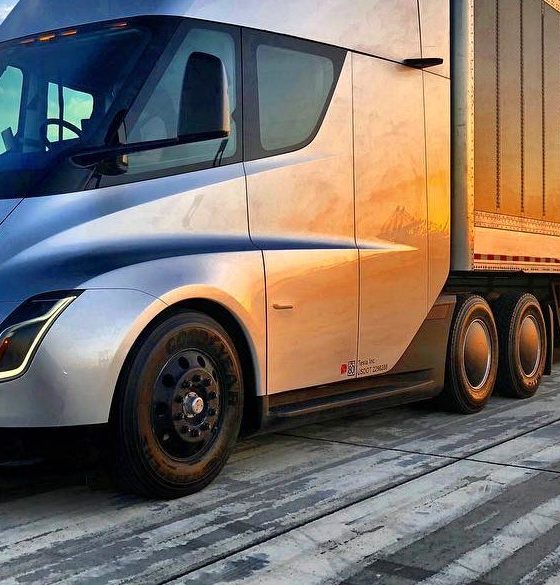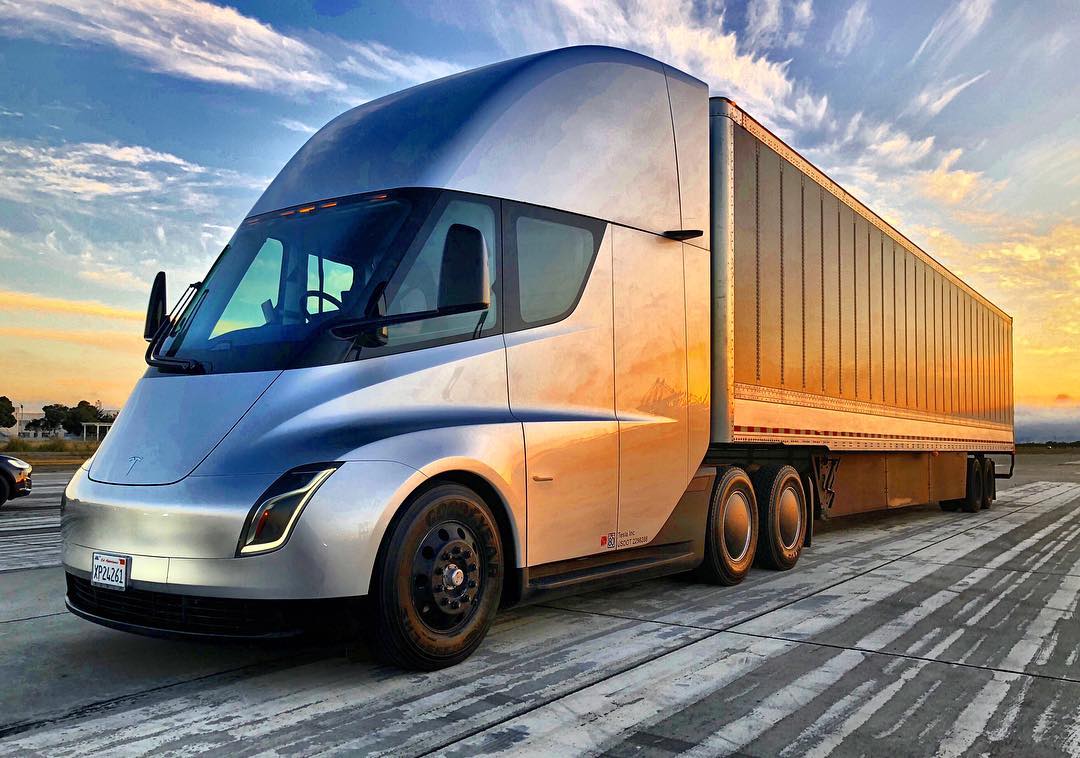

News
Tesla Semi ‘speed & agility’ praised by professional driver after electric truck encounter
The Tesla Semi is currently traveling across the United States to gather real-world data and refine its systems before it gets released next year. Tesla seems to have brought the Semi over to be test driven by professional driver and 28-year auto veteran Emile Bouret recently as well, who walked away from the experience thoroughly impressed.
Emile Bouret is a professional test driver who has worked with Tesla for years. Bouret is a close friend of Tesla chief designer Franz von Holzhausen, and he has been asked to test drive the company’s vehicles from the Model S to the original Tesla Roadster. He was also the man who conducted test drives in the next-generation Tesla Roadster during the vehicle’s unveiling last November.
The professional driver recently posted an update on his Instagram about the Tesla Semi, lauding the electric long-hauler for its speed and agility, stating that the truck’s performance is practically at odds with its size. Bouret’s caption on his Instagram post suggests that he actually got some hands-on time with the electric long-hauler.

“Blurring The Line | Coworker Edition – I’m clearly very lucky to do what I do & to work with many talented people. As if they could ever be overlooked, the inanimate coworkers I get to work with also tend to be incredibly capable. And that was certainly true with this one, which made a surprise appearance at a recent work site. To see this thing coming down the road in near silence & with speed & agility seemingly at odds with something of its size makes you feel as if you’re living in the future. Kickass cool & crazy in equal measure… the Tesla Semi.”
Tesla loves bending the rules of markets that it disrupts. When the company started selling cars, its business model did away with dealerships, shaking the very idea of how brand new cars are sold. When it seemed like GA3 would not be enough to build 5,000 Model 3 per week by the end of Q2 2018, Tesla built another assembly line inside a sprung structure at the grounds of the Fremont factory.
Now, Tesla is attempting to break into another market that is ripe for disruption — the American trucking industry — and its weapon of choice is the Tesla Semi. The Tesla Semi, just like CEO Elon Musk and the company itself, has attracted its own set of disbelievers and critics. Martin Daum, Daimler’s head of trucks, even suggested that the Tesla Semi defies the laws of physics, considering the specs announced by Musk. Jon Mills, a spokesman for engine maker Cummins Inc., largely dismissed the electric truck and its chances at the long-haul market as well, citing weak demand.
That has not stopped Tesla from pushing the Semi, though. Over the past few weeks, multiple sightings of the Semi have been reported across the United States, and during this time, the vehicle was seen visiting some of the companies that placed pre-orders for the long-hauler. Among these are UPS, J.B. Hunt, and Ruan Transportation Management Systems, all of which shared their enthusiasm for the truck online.
Just like Tesla’s other vehicles, the Semi is designed to be a long-hauler that could be driven well. This is a trademark of all Tesla electric cars to date, as the Model S, Model X, and Model 3 have all been hailed for their ride and drive. The vehicles themselves might attract criticism over their design (such as the Model X’s overcomplicated Falcon Wing Doors and the first-production Model 3’s build quality), but when it comes to drivability and performance, Tesla’s electric cars usually pass with flying colors.
This is what happened with the Model 3 during Detroit veteran Sandy Munro’s teardown and analysis of the vehicle. Munro spared no criticism when he talked about the Model 3’s panel gaps and overall build quality, but when he actually drove the electric sedan, he was impressed. Munro later noted that the person who tuned the suspension for the Model 3 could easily have been an “F1 Prince” — no small compliment coming from a man with decades of experience in the auto industry.
If Emile Bouret’s praise for the Tesla Semi is any indication, it appears that the electric long-hauler would be able to impress even its staunchest critics when it comes to the way it drives and its overall performance. Tesla, after all, has noted that it is in the process of improving the truck before it enters mass production. Elon Musk has already teased that the long-range variant of the vehicle will have closer to 600 miles of range. Making the Telsa Semi impressive to drive is just more icing on the cake.

Elon Musk
Elon Musk and Tesla AI Director share insights after empty driver seat Robotaxi rides
The executives’ unoccupied tests hint at the rapid progress of Tesla’s unsupervised Robotaxi efforts.

Tesla CEO Elon Musk and AI Director Ashok Elluswamy celebrated Christmas Eve by sharing personal experiences with Robotaxi vehicles that had no safety monitor or occupant in the driver’s seat. Musk described the system’s “perfect driving” around Austin, while Elluswamy posted video from the back seat, calling it “an amazing experience.”
The executives’ unoccupied tests hint at the rapid progress of Tesla’s unsupervised Robotaxi efforts.
Elon and Ashok’s firsthand Robotaxi insights
Prior to Musk and the Tesla AI Director’s posts, sightings of unmanned Teslas navigating public roads were widely shared on social media. One such vehicle was spotted in Austin, Texas, which Elon Musk acknowleged by stating that “Testing is underway with no occupants in the car.”
Based on his Christmas Eve post, Musk seemed to have tested an unmanned Tesla himself. “A Tesla with no safety monitor in the car and me sitting in the passenger seat took me all around Austin on Sunday with perfect driving,” Musk wrote in his post.
Elluswamy responded with a 2-minute video showing himself in the rear of an unmanned Tesla. The video featured the vehicle’s empty front seats, as well as its smooth handling through real-world traffic. He captioned his video with the words, “It’s an amazing experience!”
Towards Unsupervised operations
During an xAI Hackathon earlier this month, Elon Musk mentioned that Tesla owed be removing Safety Monitors from its Robotaxis in Austin in just three weeks. “Unsupervised is pretty much solved at this point. So there will be Tesla Robotaxis operating in Austin with no one in them. Not even anyone in the passenger seat in about three weeks,” he said. Musk echoed similar estimates at the 2025 Annual Shareholder Meeting and the Q3 2025 earnings call.
Considering the insights that were posted Musk and Elluswamy, it does appear that Tesla is working hard towards operating its Robotaxis with no safety monitors. This is quite impressive considering that the service was launched just earlier this year.
Elon Musk
Starlink passes 9 million active customers just weeks after hitting 8 million
The milestone highlights the accelerating growth of Starlink, which has now been adding over 20,000 new users per day.

SpaceX’s Starlink satellite internet service has continued its rapid global expansion, surpassing 9 million active customers just weeks after crossing the 8 million mark.
The milestone highlights the accelerating growth of Starlink, which has now been adding over 20,000 new users per day.
9 million customers
In a post on X, SpaceX stated that Starlink now serves over 9 million active users across 155 countries, territories, and markets. The company reached 8 million customers in early November, meaning it added roughly 1 million subscribers in under seven weeks, or about 21,275 new users on average per day.
“Starlink is connecting more than 9M active customers with high-speed internet across 155 countries, territories, and many other markets,” Starlink wrote in a post on its official X account. SpaceX President Gwynne Shotwell also celebrated the milestone on X. “A huge thank you to all of our customers and congrats to the Starlink team for such an incredible product,” she wrote.
That growth rate reflects both rising demand for broadband in underserved regions and Starlink’s expanding satellite constellation, which now includes more than 9,000 low-Earth-orbit satellites designed to deliver high-speed, low-latency internet worldwide.
Starlink’s momentum
Starlink’s momentum has been building up. SpaceX reported 4.6 million Starlink customers in December 2024, followed by 7 million by August 2025, and 8 million customers in November. Independent data also suggests Starlink usage is rising sharply, with Cloudflare reporting that global web traffic from Starlink users more than doubled in 2025, as noted in an Insider report.
Starlink’s momentum is increasingly tied to SpaceX’s broader financial outlook. Elon Musk has said the satellite network is “by far” the company’s largest revenue driver, and reports suggest SpaceX may be positioning itself for an initial public offering as soon as next year, with valuations estimated as high as $1.5 trillion. Musk has also suggested in the past that Starlink could have its own IPO in the future.
News
NVIDIA Director of Robotics: Tesla FSD v14 is the first AI to pass the “Physical Turing Test”
After testing FSD v14, Fan stated that his experience with FSD felt magical at first, but it soon started to feel like a routine.

NVIDIA Director of Robotics Jim Fan has praised Tesla’s Full Self-Driving (Supervised) v14 as the first AI to pass what he described as a “Physical Turing Test.”
After testing FSD v14, Fan stated that his experience with FSD felt magical at first, but it soon started to feel like a routine. And just like smartphones today, removing it now would “actively hurt.”
Jim Fan’s hands-on FSD v14 impressions
Fan, a leading researcher in embodied AI who is currently solving Physical AI at NVIDIA and spearheading the company’s Project GR00T initiative, noted that he actually was late to the Tesla game. He was, however, one of the first to try out FSD v14.
“I was very late to own a Tesla but among the earliest to try out FSD v14. It’s perhaps the first time I experience an AI that passes the Physical Turing Test: after a long day at work, you press a button, lay back, and couldn’t tell if a neural net or a human drove you home,” Fan wrote in a post on X.
Fan added: “Despite knowing exactly how robot learning works, I still find it magical watching the steering wheel turn by itself. First it feels surreal, next it becomes routine. Then, like the smartphone, taking it away actively hurts. This is how humanity gets rewired and glued to god-like technologies.”
The Physical Turing Test
The original Turing Test was conceived by Alan Turing in 1950, and it was aimed at determining if a machine could exhibit behavior that is equivalent to or indistinguishable from a human. By focusing on text-based conversations, the original Turing Test set a high bar for natural language processing and machine learning.
This test has been passed by today’s large language models. However, the capability to converse in a humanlike manner is a completely different challenge from performing real-world problem-solving or physical interactions. Thus, Fan introduced the Physical Turing Test, which challenges AI systems to demonstrate intelligence through physical actions.
Based on Fan’s comments, Tesla has demonstrated these intelligent physical actions with FSD v14. Elon Musk agreed with the NVIDIA executive, stating in a post on X that with FSD v14, “you can sense the sentience maturing.” Musk also praised Tesla AI, calling it the best “real-world AI” today.








